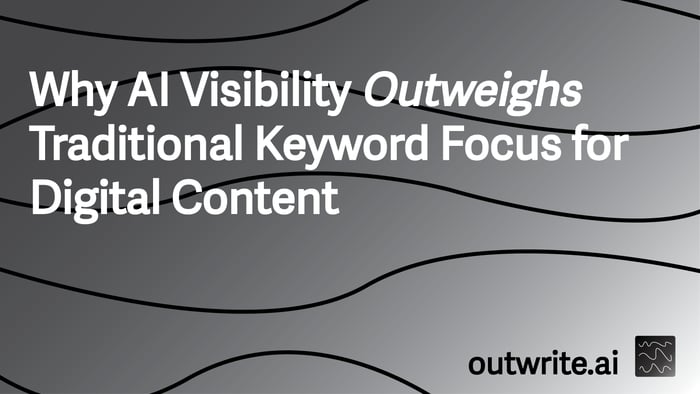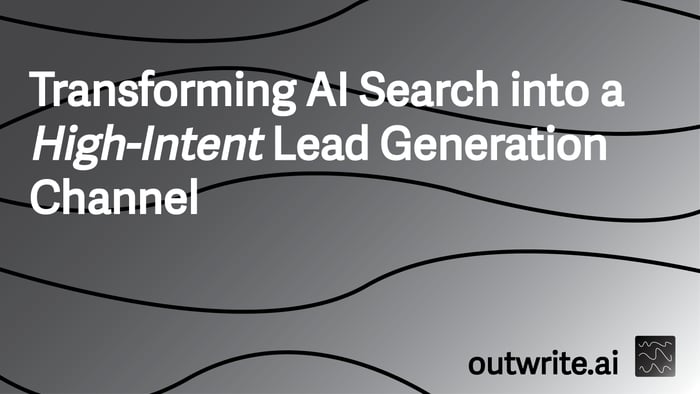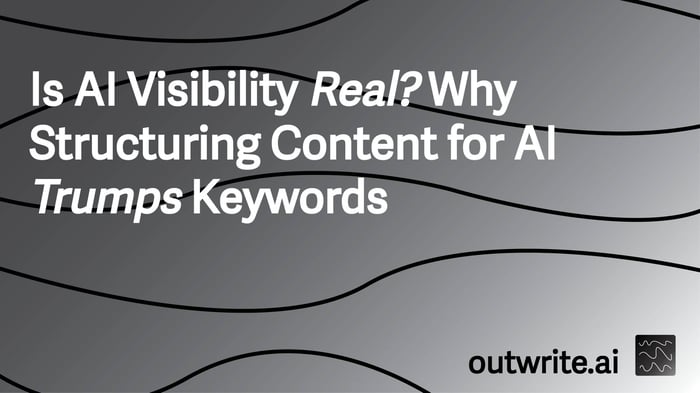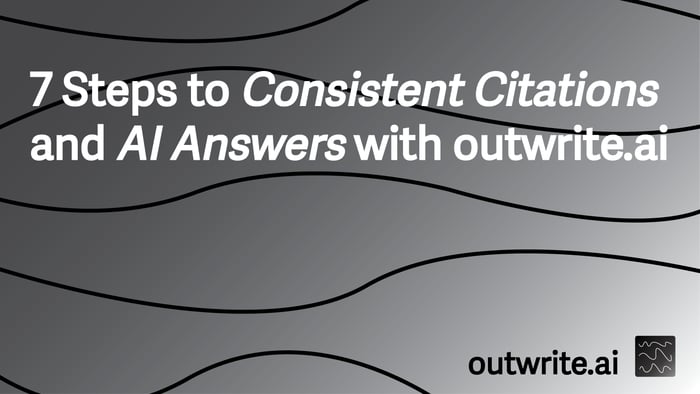Table of Contents
- AI Overviews and the New Search Paradigm
- Semantic Understanding vs. Exact Match Focus
- Content Recency and Authoritativeness in AI Search
- The Value of AI-Driven Traffic and Engagement
- AI in Content Creation and Optimization
- Strategic Implementation for AI Visibility
- Case Studies in AI Visibility
- The Role of AI Tools in Achieving Visibility
- Frequently Asked Questions (FAQ)
- Conclusion: Embracing the AI-First Content Future
The digital landscape is undergoing a profound transformation, driven by the rapid advancements in AI technology. For decades, the cornerstone of digital content strategy has been traditional keyword focus, meticulously researching and optimizing for specific search terms to capture organic traffic. However, a new strategic imperative has emerged: AI visibility. This shift signifies a move beyond mere keyword rankings to a more holistic approach where content is optimized for understanding and surfacing by sophisticated AI algorithms. The very nature of search is evolving, with AI Overviews and AI-powered conversational interfaces becoming increasingly prevalent, fundamentally altering how users discover and interact with information.
This article will delve into why AI visibility now outweighs traditional keyword focus for digital content success. We will explore the compelling data and expert insights that underscore this paradigm shift, examine the core principles of AI-driven content optimization, and provide practical strategies for businesses to adapt and thrive in this new era. From understanding semantic intent to prioritizing content recency and building brand authority, the focus will be on how to position your digital assets to be discovered and valued by the AI technology trends that govern today's search ecosystem.
AI Overviews and the New Search Paradigm
The advent of AI Overviews in search results marks a pivotal moment, fundamentally reshaping the dynamics of digital visibility. These AI-generated summaries, appearing directly at the top of search engine results pages (SERPs), condense information from various sources to provide immediate answers. This changes the game for content creators, as the goal is no longer just to rank high in the "blue links" but to be the authoritative source cited within these AI summaries.
Current data unequivocally highlights the growing dominance of AI Overviews. According to Ahrefs and BrightEdge's 2025 data, AI Overviews now appear for a significant 9.46% of all keywords, representing a staggering 116% increase in AI overview generation since March 2024. This rapid adoption signals a clear direction for search engines, prioritizing AI-curated results. The implications for content strategy are profound: if your content isn't structured for AI comprehension, it risks being overlooked in this new, condensed search environment.
A critical insight from this shift is the diminished correlation between traditional keyword ranking and AI visibility. While ranking first in Google's traditional blue links was once the ultimate goal, sites holding this position have only a 25% chance of being featured as AI Overview sources. This stark statistic emphasizes that traditional SEO metrics, while still relevant, are no longer sufficient. Instead, brand mentions strongly correlate with visibility in AI Overviews, indicating that building a strong, recognizable brand presence is increasingly vital for AI-driven discovery.
The user behavior associated with AI Overviews further solidifies their importance. TrustRadius data, cited by Ahrefs, reveals that an impressive 90% of buyers click through to sources featured in AI Overviews. This translates directly to high-intent traffic and conversions, making AI visibility a direct driver of business outcomes. While AI users may consume fewer pages, they spend longer per session, implying deeper engagement with singular, authoritative sources. This shift demands content that is not only discoverable by AI but also deeply valuable and trustworthy to the end-user.
What are the key characteristics of the new search paradigm?
- AI-Generated Summaries: Search results increasingly feature AI Overviews that provide concise answers directly on the SERP, reducing the need for users to click through to multiple websites.
- Intent-Based Matching: AI prioritizes understanding the user's underlying intent and context rather than just matching exact keywords, leading to more relevant and comprehensive answers.
- Source Authority: AI algorithms evaluate the authority and trustworthiness of content sources, often favoring established brands and expert authors.
- Reduced Traditional CTR: The presence of AI Overviews can significantly reduce click-through rates on traditional organic blue links, making AI visibility paramount for traffic.
Semantic Understanding vs. Exact Match Focus
The evolution from traditional keyword focus to AI visibility is fundamentally rooted in the shift from exact match keyword targeting to semantic understanding. Historically, SEO revolved around identifying specific keywords and meticulously integrating them into content to signal relevance to search engines. This often led to content that felt unnatural or "stuffed" with keywords, prioritizing machine readability over human comprehension.
However, modern AI technology, particularly in natural language processing (NLP), has enabled search engines to grasp the nuances of language, context, and user intent. AI-powered algorithms can now understand the relationships between words, identify synonyms, and comprehend complex queries, moving beyond simple keyword matching. This means that instead of optimizing for a single phrase like "best coffee shops in New York," AI tools can recognize the semantic equivalence of "top coffee shops in NYC" or "finest cafes in Manhattan," allowing for a broader and more natural content strategy.
This semantic understanding empowers AI to identify related concepts and semantic clusters, expanding topic coverage and audience reach far beyond narrow exact matches. For instance, a traditional approach might focus solely on "digital marketing strategies." An AI-driven approach, however, would identify related topics like "content marketing best practices," "SEO for small businesses," and "social media advertising trends," recognizing their interconnectedness and building comprehensive topic clusters that address a wider range of user queries and intents.
The impact of this shift is measurable. A HubSpot study highlights that companies leveraging AI-driven keyword research tools, such as Semrush and Ahrefs, have observed an average 25% increase in content visibility and engagement. This improvement is directly attributable to AI's ability to perform semantic clustering and context understanding, enabling content creators to produce more relevant and comprehensive material that resonates with a wider audience and is better understood by AI algorithms.
Why is semantic understanding more important than exact match?
- Natural Language Processing (NLP): AI excels at understanding human language, context, and intent, making exact keyword matches less critical than comprehensive topic coverage.
- Broader Reach: Semantic understanding allows content to rank for a wider array of related queries, including long-tail and conversational searches, expanding potential audience.
- Improved User Experience: Content written naturally for human readers, rather than stuffed with keywords, provides a better experience, which AI algorithms also favor.
- Future-Proofing: As AI search evolves, focusing on semantic relevance ensures content remains discoverable even as query patterns change.
Content Recency and Authoritativeness in AI Search
Beyond semantic understanding, two critical factors have gained immense prominence in the age of AI visibility: content recency and authoritativeness. Unlike traditional SEO, which often prioritized evergreen content and established backlinks, AI algorithms place a significant premium on up-to-date information and credible sources. This shift reflects AI's goal to provide the most accurate, relevant, and current answers to user queries.
The emphasis on recency is clearly demonstrated in AI Overviews. Seer Interactive's 2025 study reveals a strong bias toward recent content, with approximately 44% of citations originating from 2025 alone, and 30% from 2024. Overall, about 85% of citations in AI Overviews are from between 2023 and 2025. This data underscores that freshness is a significant ranking factor for AI, often outweighing the historical authority that might come from older, albeit well-optimized, content. For businesses, this means a continuous content refresh strategy is not just beneficial but essential for maintaining AI visibility.
Authoritativeness, too, has evolved. While backlinks remain important, AI algorithms are increasingly sophisticated in assessing the credibility and expertise of content creators and their sources. This includes evaluating author bios with credentials, the overall reputation of the publishing domain, and the consistent accuracy of information presented. Informatics Inc. emphasizes that traditional keyword mastery is insufficient because AI tools like Google's AI Mode and ChatGPT prioritize intent and context over keywords, and they value consistent branding and narrative presence to maintain visibility. Gartner predicts a 25% decline in traditional search engine volume by 2026, further highlighting the need for brands to establish themselves as trusted voices that AI can confidently cite.
To establish authoritativeness in the eyes of AI, content creators must adopt strategies that signal expertise, experience, authority, and trustworthiness (E-E-A-T). This includes ensuring factual accuracy, citing reputable sources, and presenting information in a clear, structured manner that AI can easily parse and validate. Tools like outwrite.ai are designed to help content creators structure their content to meet these evolving AI requirements, ensuring that information is presented in a way that is both human-readable and AI-digestible, boosting its chances of being recognized as authoritative and recent.
| Content Age | Percentage of Citations | Implication for Content Strategy |
|---|---|---|
| 2025 Content | 44% | Prioritize immediate updates and new content creation. |
| 2024 Content | 30% | Regularly review and refresh content from the previous year. |
| 2023 Content | 11% | Older content needs significant updates or re-writes to remain visible. |
| Pre-2023 Content | 15% | Likely to be overlooked unless it's foundational and frequently updated. |
How to enhance content recency and authoritativeness for AI?
- Regular Content Audits: Periodically review and update existing content with the latest information, statistics, and trends.
- Date Stamping: Ensure content is clearly dated and update the publication date upon significant revisions.
- Expert Contributions: Feature content written or reviewed by subject matter experts with clear author bios and credentials.
- Cite Authoritative Sources: Link to reputable, high-authority domains (.gov, .edu, established industry publications) to bolster credibility.
- Build Brand Trust: Consistently produce accurate, unbiased, and valuable content that positions your brand as a reliable source of information.
The Value of AI-Driven Traffic and Engagement
The shift towards AI visibility is not merely about adapting to new search algorithms; it's about capturing a new, highly valuable form of digital traffic. While traditional organic search traffic remains important, the quality and intent of users arriving via AI-driven channels are proving to be significantly superior. This makes AI visibility a direct pathway to more engaged users and higher conversion rates.
The data supporting the increased value of AI-driven traffic is compelling. Semrush reports that website visitors from AI search are an astounding 4.4 times more valuable than those from organic search. This higher value can be attributed to several factors: AI Overviews often answer complex queries, meaning users who click through are typically seeking deeper, more specific information. They are already past the initial information-gathering stage and are often closer to a decision point, making them high-intent leads.
Furthermore, the sheer scale of AI platform usage underscores the potential for massive reach. ChatGPT alone receives over 5 billion monthly visits in 2025, ranking as the #5 globally for website visits. This immense user base represents a vast audience engaging directly with AI for information, problem-solving, and decision-making. Being visible within these AI interactions means tapping into a highly active and engaged segment of the internet population.
While AI users might consume fewer pages per session compared to traditional organic search users, they tend to spend longer on the pages they do visit. This indicates a deeper level of engagement and a higher likelihood of finding the exact information they need. For content creators, this means focusing on comprehensive, well-structured content that fully addresses a user's intent, rather than optimizing for quick clicks and shallow engagement. The goal is to become the definitive source that AI trusts and users rely on.
What makes AI-driven traffic more valuable?
- Higher Intent: Users clicking through from AI Overviews often have more specific, complex queries, indicating they are further along in their decision-making journey.
- Deeper Engagement: While page views might be lower, time spent on page is higher, suggesting users are finding highly relevant and comprehensive answers.
- Authoritative Referrals: Being cited by AI platforms like Google's AI Overviews or ChatGPT lends significant credibility, acting as a powerful endorsement for your brand.
- Reduced Bounce Rates: Because content is highly relevant to the AI-interpreted query, users are less likely to bounce quickly, leading to better engagement metrics.
AI in Content Creation and Optimization
The influence of AI technology extends beyond search visibility; it is rapidly transforming the very process of content creation and optimization. Businesses are increasingly leveraging AI tools to generate, refine, and strategically position their digital content, recognizing that AI-powered content is often better equipped to achieve AI visibility.
The adoption of AI in content creation is widespread and growing. By 2025, a significant 74.2% of new webpages contain AI-generated content. Furthermore, an even higher percentage, 86.5% of top-ranking pages, include some form of AI content. These statistics highlight AI's pervasive role not just as a tool for analysis but as an integral part of the content production pipeline itself. This signifies that AI-driven content is not only becoming the norm but is also demonstrably performing well in search rankings.
Businesses are recognizing the competitive edge that AI provides. According to MIT Sloan, 87% of global organizations believe AI gives them a competitive edge, marking a 12% increase year-on-year. This belief translates into investment, with over 60% of businesses planning to invest in AI-driven content marketing and SEO. This investment is driven by the tangible benefits observed, particularly among small businesses.
Small businesses, often early adopters due to resource constraints, report substantial benefits from embracing AI tools. There's a 67% adoption rate among small businesses, with 42% reporting significant growth and 79% reporting improved content quality. Crucially for SEO, 65% of users noted moderate to significant improvements in SEO performance. This demonstrates that AI is not just for large enterprises; it's a scalable solution that delivers real-world results across businesses of all sizes, making AI content optimization a critical AI technology best practices.
What are the benefits of using AI in content creation and optimization?
- Efficiency and Scale: AI tools can rapidly generate content drafts, outlines, and summaries, significantly speeding up the content production process.
- Improved Quality: AI can assist in refining grammar, style, tone, and readability, leading to higher-quality content that resonates with audiences.
- Enhanced SEO Performance: AI helps identify semantic gaps, optimize for intent, and ensure content is structured in a way that AI algorithms prefer.
- Personalization: AI can analyze user data to create personalized content experiences, increasing engagement and conversion rates.
- Competitive Edge: Leveraging AI for content creation and optimization allows businesses to stay ahead of competitors who rely solely on traditional methods.
Strategic Implementation for AI Visibility
Achieving AI visibility requires a deliberate and strategic shift from traditional SEO tactics. It's no longer enough to simply target keywords; content must be designed for AI comprehension, brand authority, and user intent. This involves a multi-faceted approach that touches upon content structure, quality, and technical optimization.
One of the foremost strategies is to shift focus to AI visibility, not just rankings. As AI answers increasingly dominate search results, the click-through rates (CTR) on traditional organic listings are declining. Studies indicate that CTR on traditional results can drop from approximately 28% to 11% on desktop when AI summaries are shown. This means that being cited prominently within the AI answer, ideally near the beginning, is paramount for your brand to be seen and for users to engage with your content. This requires understanding how AI synthesizes information and structuring your content accordingly.
Another critical strategy is to create structured, clear, and specific content. AI algorithms favor content that is easy to parse and understand. This means utilizing clear subheadings (H2, H3, H4), concise answers to potential questions, and detailed, structured long-form content that breaks down complex queries into digestible segments. For example, instead of a vague title like "ERP tools you can't live without," a more AI-friendly approach would be "Best ERP systems for $10M–$50M manufacturers." This specificity helps AI accurately categorize and surface your content for highly targeted queries. Tools like outwrite.ai can assist in structuring content for optimal AI readability and comprehension.
Building authoritative and trustworthy signals is also vital. Just as Google values backlinks for traditional SEO, AI algorithms assess the credibility of content sources. Incorporating author bios with clear credentials, demonstrating expertise, experience, authority, and trustworthiness (E-E-A-T), significantly boosts AI's perception of your content's reliability. This includes citing reputable sources, providing data-backed claims, and maintaining a consistent, expert tone. Finally, optimizing speed, user experience, and clean code remains crucial. AI algorithms, like human users, favor sites that load quickly, are easy to navigate, and have clean, semantic code, ensuring efficient indexing and retrieval of information.
- Prioritize AI Answer Optimization: Focus on creating content that directly answers common questions and provides concise, factual information that AI can easily extract for summaries.
- Implement Semantic Topic Clusters: Organize your content around broad topics, with individual articles addressing specific sub-topics, to signal comprehensive authority to AI.
- Enhance E-E-A-T Signals: Clearly display author expertise, provide evidence for claims, and build a reputation as a trusted source in your niche.
- Optimize for Conversational Search: Write content that anticipates natural language queries, including questions and long-tail phrases, mimicking how users interact with AI.
- Maintain Content Freshness: Regularly update and refresh existing content to ensure it remains current and relevant, aligning with AI's bias towards recency.
Case Studies in AI Visibility
The theoretical shift towards AI visibility is best understood through practical examples and real-world case studies. These demonstrate how businesses are successfully adapting their content strategies to capture the benefits of AI-driven search and engagement. By examining these instances, we can glean actionable insights into effective AI technology strategies.
One compelling example comes from Bytebard, a UK retail website, which faced significant challenges with product page visibility and the laborious task of manually updating meta-tags. Recognizing the limitations of traditional methods, Bytebard integrated AI-powered tools to revolutionize their SEO approach. Their strategy focused on three key areas: long-tail keyword targeting based on trend analysis (e.g., “best waterproof hiking shoes for men”), dynamic semantic keyword clustering (e.g., “women’s workout leggings,” “high-waist yoga pants”), and predictive search intent analysis (e.g., “trendy summer sandals 2024”).
The results for Bytebard were transformative. They experienced improved organic visibility, a significant increase in intent-driven traffic, and the elimination of duplicate content issues through AI-generated metadata. This case demonstrates that AI not only streamlines content optimization but also enables a more nuanced and effective targeting of user intent, leading to tangible business outcomes. The success of Bytebard underscores the power of AI to move beyond simple keyword matching to truly understand and cater to user needs, thereby enhancing visibility in AI-driven search environments. This case study is a testament to the effectiveness of AI-based solutions to tackle retail SEO challenges.
Another illustrative example, though not a specific company name, is the general trend observed in SaaS and B2B sectors. Companies in these industries are increasingly focusing on creating comprehensive, structured content that directly answers complex industry questions. Instead of generic blog posts, they are producing detailed guides, whitepapers, and comparison articles that break down intricate topics into easily digestible, AI-parsable sections. This approach, often supported by AI tools for content structuring and semantic analysis, positions them as authoritative sources that AI algorithms are more likely to cite in their summaries, leading to high-intent leads and increased brand visibility among decision-makers. This aligns with the principles of AI visibility optimization.
What can we learn from successful AI visibility case studies?
- AI Streamlines Optimization: AI tools can automate and enhance tasks like metadata generation, long-tail keyword identification, and semantic clustering, saving time and improving accuracy.
- Intent-Driven Focus: Successful cases prioritize understanding and addressing user intent over simple keyword matching, leading to more relevant traffic.
- Structured Content is Key: Content organized with clear headings, concise answers, and logical flow is more easily processed and cited by AI.
- Tangible ROI: AI visibility strategies lead to measurable improvements in organic traffic, engagement, and ultimately, conversions.
The Role of AI Tools in Achieving Visibility
In the evolving landscape of digital content, AI tools are no longer just supplementary; they are indispensable for achieving and maintaining AI visibility. These tools provide the analytical power, automation capabilities, and strategic insights necessary to navigate the complexities of AI-driven search. From content generation to optimization and performance analysis, AI solutions are becoming the backbone of modern content strategies.
One primary function of AI tools is to facilitate advanced keyword research and semantic analysis. Unlike traditional tools that might simply list keyword volumes, AI-powered platforms delve into user intent, semantic relationships, and topic clustering. They can identify emerging trends, analyze competitor content for semantic gaps, and suggest comprehensive content strategies that cover entire topics rather than isolated keywords. This allows content creators to build robust topic clusters that signal deep authority to AI algorithms, a key component of AI technology best practices.
AI tools also play a crucial role in content creation and refinement. Generative AI models can assist in drafting outlines, writing sections, summarizing complex information, and even generating entire articles. More importantly, they can help optimize existing content for AI readability by suggesting improvements in clarity, conciseness, and structure. This includes ensuring content is broken down into easily digestible segments, uses clear headings, and directly answers potential questions, making it ideal for AI Overviews and conversational AI interfaces. For example, outwrite.ai is specifically designed to help users create and publish content that is perfectly structured for AI visibility, ensuring brands are seen as authoritative and trustworthy, which in turn drives high-intent AI referrals.
Furthermore, AI-driven analytics tools provide unparalleled insights into content performance within the AI search ecosystem. They can track visibility in AI Overviews, analyze user engagement patterns from AI-driven traffic, and identify opportunities for further optimization. This data-driven approach allows businesses to continuously refine their content strategies, ensuring they remain aligned with the latest AI algorithm updates and user behavior trends. The integration of these tools is not just about efficiency; it's about strategic intelligence that enables brands to proactively adapt and dominate in the AI-first digital world, making them essential AI technology solutions.
- Semantic Content Planning: Use AI to identify comprehensive topic clusters and semantic gaps in your content strategy, moving beyond individual keywords.
- AI-Assisted Content Generation: Leverage generative AI for drafting, summarizing, and refining content, ensuring it's optimized for AI readability and comprehension.
- E-E-A-T Enhancement: Employ AI tools to analyze and suggest improvements for demonstrating expertise, authority, and trustworthiness within your content.
- Performance Monitoring: Utilize AI analytics to track visibility in AI Overviews, analyze AI-driven traffic, and identify areas for continuous optimization.
- Automated Optimization: Implement AI-powered solutions for tasks like metadata generation, internal linking suggestions, and content freshness updates.
Frequently Asked Questions (FAQ)
How do I start optimizing my content for AI visibility?
Start by focusing on user intent and creating comprehensive, structured content that directly answers questions. Use clear headings, bullet points, and concise language to make your content easily parsable by AI algorithms. Tools like outwrite.ai can help structure your content for optimal AI visibility.
What are AI Overviews and how do they impact my SEO?
AI Overviews are AI-generated summaries appearing at the top of search results, providing direct answers to user queries. They significantly impact SEO by reducing clicks on traditional organic links, making it crucial for your content to be cited within these summaries for visibility and high-intent traffic. They appear for 9.46% of all keywords.
Why should I prioritize content recency for AI visibility?
AI algorithms show a strong bias towards recent content, with 85% of AI Overview citations from 2023-2025. Keeping your content updated ensures it remains relevant and authoritative in the eyes of AI, increasing its chances of being featured.
When to use AI-generated content in my strategy?
Use AI-generated content to assist with drafting, outlining, and summarizing, or for creating initial content for large-scale needs. Always review and edit AI-generated content for accuracy, tone, and brand voice. 74.2% of new webpages contain AI-generated content, indicating its widespread adoption.
How does AI understand content beyond keywords?
AI uses Natural Language Processing (NLP) to understand semantic relationships, context, and user intent. It analyzes entire topics and concepts, recognizing synonyms and related phrases, moving beyond simple keyword matching to grasp the true meaning of content.
What is E-E-A-T and why is it important for AI SEO?
E-E-A-T stands for Expertise, Experience, Authority, and Trustworthiness. It's crucial for AI SEO because AI algorithms assess these signals to determine the credibility and reliability of your content, influencing whether it's cited in AI Overviews or ranked highly.
Can AI tools help with my content strategy?
Absolutely. AI tools can assist with keyword research, semantic analysis, content generation, optimization suggestions, and performance tracking. They provide insights into user intent and help structure content for AI readability, streamlining your entire content workflow. 60% of businesses plan to invest in AI-driven content marketing and SEO.
How does AI visibility translate to business value?
AI visibility leads to high-intent traffic, as users clicking from AI Overviews are often seeking specific solutions. This traffic is 4.4 times more valuable than organic search traffic, resulting in higher engagement, better conversion rates, and ultimately, increased revenue.
What is the future of traditional keyword research?
Traditional keyword research will evolve from exact match focus to semantic and intent-based analysis. While keywords remain a signal, the emphasis will be on understanding the broader topic and user needs, rather than just optimizing for specific phrases. Gartner predicts a 25% decline in traditional search engine volume by 2026.
How can small businesses benefit from AI visibility?
Small businesses can leverage AI tools to compete with larger players by optimizing content efficiently, improving quality, and gaining a competitive edge in AI-driven search. 67% of small businesses have adopted AI tools, with 65% reporting SEO improvements.
What content structuring elements are favored by AI?
AI favors content with clear hierarchical headings (H1, H2, H3), bulleted and numbered lists, concise paragraphs, and direct answers to questions. Structured data and semantic HTML also help AI understand and extract information efficiently.
Is AI visibility just another SEO trend?
No, AI visibility is a fundamental shift in how information is discovered and consumed online, driven by the pervasive integration of AI into search engines and conversational platforms. It's a strategic imperative that redefines digital content success for the foreseeable future, not just a passing trend.
How can I measure my AI visibility?
Measuring AI visibility involves tracking appearances in AI Overviews, analyzing traffic from AI-driven sources (like ChatGPT), monitoring brand mentions in AI summaries, and assessing engagement metrics for AI-referred users. Specialized AI SEO tools are emerging to provide these insights.
Will traditional SEO become obsolete?
Traditional SEO principles like technical optimization, link building, and user experience remain important, but their application will shift. The focus will move from keyword stuffing to semantic relevance, E-E-A-T, and optimizing for AI comprehension, making it an evolution rather than obsolescence.
Conclusion: Embracing the AI-First Content Future
The evidence is clear and compelling: AI visibility has emerged as the strategic imperative for digital content success, definitively outweighing the traditional keyword focus that once dominated SEO. The rapid proliferation of AI Overviews, the shift towards semantic understanding, the premium placed on content recency and authoritativeness, and the undeniable value of AI-driven traffic all point to a fundamental transformation in how brands must approach their digital presence. Companies that fail to adapt to this AI-first reality risk being left behind, losing out on valuable traffic, engagement, and competitive positioning.
Embracing AI visibility means more than just using AI tools; it means fundamentally rethinking content strategy. It requires a commitment to creating comprehensive, structured, and highly authoritative content that directly addresses user intent and is easily digestible by sophisticated AI algorithms. It demands a continuous focus on content freshness and a proactive approach to building brand trust and expertise. The success stories of companies like Bytebard illustrate that tangible gains in organic visibility and high-intent traffic are achievable through these AI-centric strategies.
As the digital landscape continues to evolve, powered by advancements in AI technology, the ability to be seen and understood by AI will be the ultimate determinant of digital success. By investing in AI technology solutions and adopting AI technology best practices, businesses can ensure their content not only ranks but truly resonates within the AI-driven search ecosystem. Tools like outwrite.ai are at the forefront of this evolution, empowering content creators to structure their content for optimal AI visibility, ensuring their brand is recognized as authoritative and trustworthy, and ultimately driving high-intent AI referrals and inbound leads. The future of digital content is AI-driven, and visibility within this new paradigm is the key to unlocking unprecedented growth.
Authored by Aidan Buckley, Subject matter expert at outwrite.ai.





